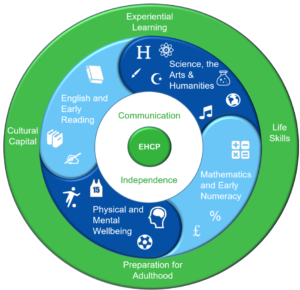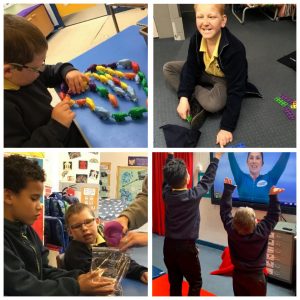Our Curriculum Offer
Green Meadows Academy Curriculum Model (click to expand)
Our Mission
At Green Meadows Academy, we envision a world where every child, regardless of the barriers to their learning, is provided with the opportunity to thrive, grow, and succeed. Our mission is to be a centre of excellence for children with special educational needs and disabilities who are happy, successful and well supported.
Our core values are rooted in a commitment to the belief that every child can be empowered to succeed in a compassionate and inclusive environment. We are dedicated to providing a nurturing and supportive setting where our students can thrive academically, socially, and emotionally.
Empower We empower our students to embrace their individuality and develop the skills and confidence needed to overcome challenges. Through tailored education plans, we aim to unlock their full potential and foster a sense of self-worth.
Nurture We foster an inclusive community that values diversity and celebrates differences. Our school is a place where acceptance, respect, and understanding are the cornerstones of our daily interactions.
Thrive We are committed to excellence in education and support services. Our dedicated team of educators continually strive to improve their skills and find and apply the best practices in the field of special education.
At Green Meadows Academy, we measure our success not only by academic achievements but also by the growth in independence, self-advocacy, and happiness of our students. Together, with unwavering dedication and a shared commitment to our mission, we transform lives, one child at a time.
Empower – Nurture – Thrive
You can see a copy of our updated Curriculum Policy here.
Communication:
Key to our success in every area is our approach to communication. Communication underpins all areas of the curriculum and allows pupils to access learning and develop relationships. Our ultimate aim for all pupils is that they will establish a system of expressive and receptive communication in whatever form is appropriate to them. Specific details are set out in our Communication Strategy.
You can see a copy of our updated Communication strategy here
How our curriculum is implemented: Our Approach:
In the classroom we use a multi-method approach that integrates knowledge about special educational needs and the way children learn.
In every classroom you will see teachers…
- Promoting communication to engage pupils and develop their understanding of key concepts. As pupils become more effective verbal communicators, they will share ideas, enhance and expand their understanding, challenge and support thinking through talk.
- Using stories to stimulate thinking, reinforce key concepts, develop understanding, challenge ideas and increase vocabulary development.
- Scaffolding learning to ensure pupils are as independent as possible.
- Ensuring over- learning of key concepts and skills takes place.
- Ensuring pupils are learning at their ‘zone of proximal development’
- Teach skills and knowledge following the ‘gradual release of responsibility’ model
How the Curriculum is Organised:
Our Curriculum is divided into seven areas:
| Curriculum Area | This area includes aspects of: |
| Communication and English | Speaking and listening, reading, writing, social interaction |
| Maths and Finances | Number, using and applying maths, shape, space and measure |
| My Body | PSHE, RSE and emotional wellbeing, physical education, physical development, health and wellbeing |
| My Community | History, geography, religious education |
| Creative Me | Music, art and drama |
| My World | Science, IT, Design Technology, Food Technology |
| Future Me | Personal Development, careers, vocational learning, emotional wellbeing, Duke of Edinburgh Award, work experience, independence passports, preparation for adulthood |
Our Curriculum planning frameworks can be found by clicking here.

